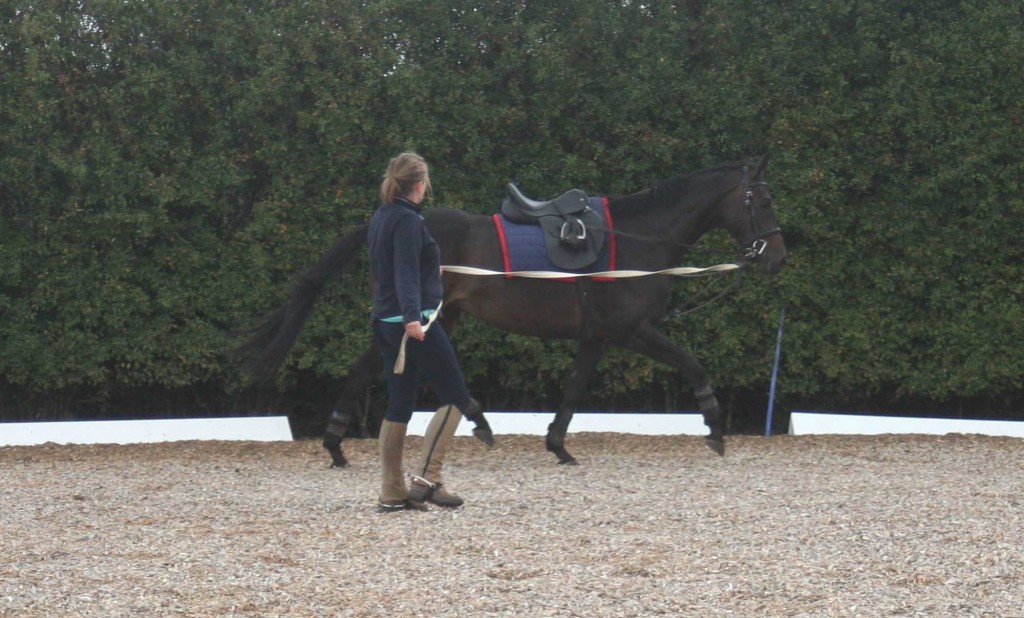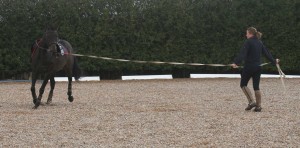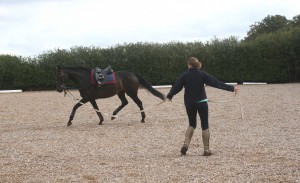In the fourth part of the series on ‘Ground Training’, Fred and Rowena Cook (of Equine Management and Training) look into the basic technique of lunging and how to correctly use equipment.
Lunging essentials

How not to lunge: This lady is holding the lunge rein in her left hand instead of her right and she is positioned too close to the hindquarters; she would have not control over the horse if it decided to scoot off or turn in. She is moving with the horse which is good but if the horse kicked out, she is in the line of fire.
Attaching the lunge line – cavesson, coupling or directly to the bit?
Whilst deemed to be the correct an accurate method in classical training as it teaches acceptance of and contact with the bit, attaching the lunge line directly to the bit is fraught with negatives. The horse can get severely pulled in the mouth if he dives away, the bit can get pulled too much to the inside, if the horse gets is tongue over the bit he can become very difficult to control until you have got the tongue back – and meanwhile damage is being done. As horses naturally pull to the outside there is a danger of too much “pull” from the trainer to the inside; this has the effect of locking and fixing the horse laterally and ultimately causing him to look to the outside..
Most lunge cavessons slip round on the horse’s face with the result that the off-side eye is virtually covered; some are quite heavy and lack adequate padding on the nose. The benefit of using a cavesson is that a horse can be worked without any interference with his mouth although of course he can carry the bit. The cavesson made by Equiami is very lightweight and remains firmly in place so if you are a cavesson fan, use one of these.
Note: some horses will not move forward properly as they do not like the lunge line attached to the central ring. Also a horse that has the tendency to rush off cannot be controlled properly when the lunge line is attached in this manner.
Many people do it, but we do not like the practise of fitting of the lunge rein over the horse’s head. This method puts untold and unnecessary pressure on the poll and has the effect of pulling the corners of the mouth upwards (as a gag bit does) resulting in the head and neck being raised. As the outside bit ring is pulled up tighter than on the inside, in order to relieve discomfort some horses will develop a head tilt. When combined with the use of a training aid to help encourage lowering and stretching his neck, he will likely invert because he is receiving conflicting instructions from the bit and the aid.

The typical error of the horse’s head being pulled to the inside.
As we do not carry out much single line lunge work our preferred method when doing so is to use a 3-way coupling as it provides an even pressure to both sides of the mouth and the central nose attachment prevents the bit to one side whereas using a 2-way coupling allows too much pressure to be put on the outside bit ring. The 3-way coupling affords great control with a strong horse and those that try and rush off.
Racehorses do get lunged but this usually takes place in a pen designed for the purpose, so when you undertake your first lunge session proceed as you would for a horse that has not lunged before.
The benefits of single lunge work are:
But for proper benefit then two lines should be used – double lunging:
Remember:
Lunging sessions
Your lunge work sessions should include plenty of transitions and changes of pace, lengthening and shortening of the stride and spiralling in and out. The skilled handler can teach half-halts but you should be very clear about how to go about this before attempting. The success of carrying out lunge work is entirely dependent upon your communication skills. You have to keep your horse’s attention and be very clear in your body language, voice commands and handling of the lunge line itself.

With some guidance this lady has now go the hang of things and her mare is co-operating nicely.
Do not root yourself to the spot but move with your horse. This allows you to be much softer with the line and also have better control over the horse as you can work over a large area without actually giving out too much length of lunge line. And by moving you are much less likely to pull your horse inwards.
Work on the single lunge in the majority of cases is not carried out correctly with invariably horses not being straight as they have their heads turned in, or more often than not, pulled to the inside (so the quarters swing out). This causes people to reach for a training aid with the effect of falsely correcting the horse. Another fault is that people lunge on the same size circle on the same rein for too long, pulling on the line in attempts to create inside bend, to control speed and establish a contact.
Fred and Rowena Cook
In the next part of this in-depth series, Fred and Rowena look at lunging with training aids.
Thoroughbred Training Consultants – Equine Management and Training
Inc Rehoming Racehorses – A Life After Racing
RoR Approved Racehorse Retrainers
Retraining Consultants to Greatwood Charity
UK Agents: Ardall Equine & Rider Safety System
Authors: “Re-Educating Racehorses – A Life After Racing”
To find your own ex-racehorse, please visit Source an Ex-Racehorse